Security of Advertising
Digital electronic advertising is diverse. The Internet, portable phones, smartphones etc. But we are primarily focused on DOOH sphere – digital informational and advertising screens that are installed in all crowded places around our cities (both LED and LCD screens).
The advantages of digital advertising are well-known: easy combination of multi-platform screens, fast growth of digital networks, instantaneous update of content, utilization of different advertising clips within one advertising campaign and changing clips depending on time of day or target audience etc. The initial investments for purchasing screens: getting administrative permissions for the installation, arranging electricity and communication links – are usually returned within a year or so, i.e. fairly fast.
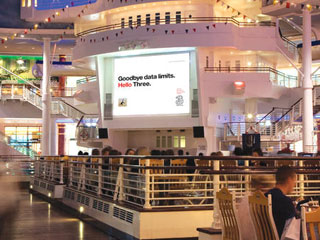 |
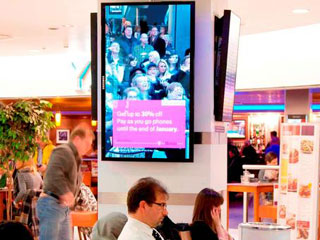 |
| Big advertising screen in Trafford Centre, Manchester Photo credit: Clear Channel |
Advertising LCD displays in Birmingham Airport Photo credit: Clear Channel |
Digital OOH Advantages
The OOH network can be controlled from a remote location (including operating screens in other countries) to save on cost and personnel, the content is updated at no cost other than the Internet traffic, the feedback functions inform operators of screen malfunctions and thus reduce the down time and repair expenses. There are more advantages, of course.
Modern screens are eco-friendly and energy efficient. They also have numerous useful functions previously unheard-of. They can broadcast commercial advertising and thus earn money to their owners, display socially valuable information (something that is necessary to appease municipal authorities), show newsreels and inform people of potential emergency situations, help in finding way around the city and even providing sound when necessary.
“Love at first sight” – an excellent slogan for the digital advertising. The idyllic picture described above takes your breath away. Operating a DOOH network seems to be easy, profits are amazing, life is cloudless . But in every story there must be a catch. There is one in this article, too. But we will continue writing about advantages for now.
Sharp reduction of price on all screens, LED and LCD alike, and cheap control systems that allow to easily merge various screen platforms made the entry threshold into a digital advertising business extremely low. To buy two-three LCD panels for a small shop and an LED screen or digital sign to place outside the entrance is not too expensive even for a small business venture. The price for a control system with the integrating video player and full software package is not high, too.
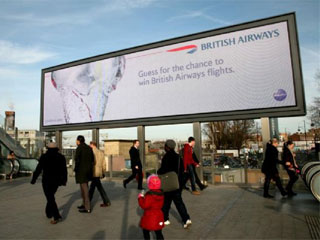 |
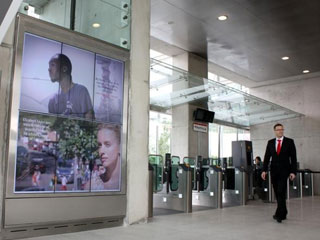 |
| Advertising LED screen Photo credit: outdoormediacentre.org.uk |
LCD video wall in London Photo credit: ooh-tv.com |
It turns out that one may build up a small digital advertising network practically everywhere at minimum expense: in lift halls of a business center or block of flats, in a drugstore or tourist agency. The time required is minimum as well. To set up an outdoor network is more complicated, primarily because of the required administrative permissions. However, from the point of view of architecture the task is manageable. You need to install screens, set up the network with the controlling PC, start up the player software and begin your local broadcast using whatever content you want: in a format of slide-show or video feed. Or as a live broadcast of any TV channel.
You see, a piece of cake. Anyone can do it. Data can be transferred via the cable (not to forget that the image quality may deteriorate if HDMI cable is too long) or via the common Wi-Fi channel. The rest depends on the imagination of your marketing specialist or specific tasks of that particular network.
Weak link of Digital OOH
A few words about the fly in the soup. Simplicity is deceptive. And dangerous. Such easy and inexpensive technological solutions lead to uncontrollable spread of local digital video networks that are built unprofessionally and therefore vulnerable for hacking. In this age of high-tech any child can read instructions on “how to become a professional hacker” in order to acquire this honorable occupation.
The English language has already reacted to this new tendency is spreading popular protests and hooliganism in the Web by coining a new word to determine these “fighters for freedom” – hacktivists. Previously teenagers would draw indecent words in chalk on fences or sidewalks. Today their task has changed: they need to study hard and learn how to hack local networks and display same offensive content on public screens. Our magazine wrote about unauthorized access to public screens in “Hackers’ attacks on large LED screens” and “Hacker’s attack on Moscow LED screens”.
Would you prefer to see standard advertising or offensive content on digital screens around the city?
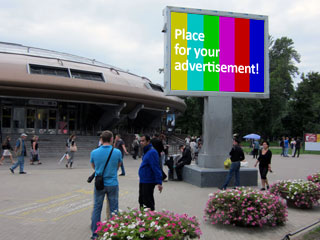 |
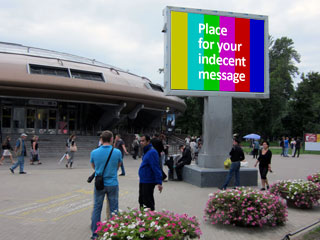 |
| Outdoor advertising LED screen is waiting... | |
Times Square screen hacked! Certainly, this screen was not hacked. This is simply a novel advertising approach to promoting a new TV series “Coma” based on the novel by Robin Cook. However it is also a good example of how the digital advertising video screens are now part of our perception from which we get a good deal of useful or not so useful information.
Video credit: youtube.com
In Russia the situation is even worse: by law the owner or the operator of a screen network is responsible for the displayed content. They should be the first to vote for strict security protocols in content transfer.
Sooner or later hacking of DOOH screens and other IP-devices will be stopped. Until then hacktivists will continue to use bugs in software and holes in legislation to create problems for public and authorities.





